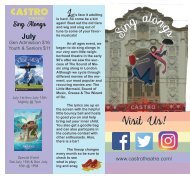You also want an ePaper? Increase the reach of your titles
YUMPU automatically turns print PDFs into web optimized ePapers that Google loves.
3) Street Artists Talk to the<br />
Press<br />
If you can Google an artist<br />
whose work is on the streets,<br />
that person is usually a street<br />
artist. Graffiti writers are<br />
reluctant to talk to the press,<br />
because most of the work<br />
they have done is illegal and<br />
they run the risk of being<br />
apprehended for work they<br />
may have done years ago.<br />
Artist Shepard Fairey, creator<br />
of the iconic Hope poster for<br />
Barack Obama’s 2008 presidential<br />
campaign, was recently<br />
arrested in Los Angeles after<br />
the Detroit Police Department<br />
issued warrants for his arrest<br />
on two counts of malicious<br />
destruction of property — for<br />
acts he allegedly committed<br />
years before.<br />
2) Graffiti is Ever-Changing<br />
You are less likely to see a graffiti<br />
piece survive the test of<br />
time — and not just because SF<br />
Public Works will buff it out. Even<br />
on permission walls, graffiti is<br />
constantly being adding to and<br />
painted over: It is the most temporary<br />
form of artwork. In contrast,<br />
much of the famous street<br />
art in San Francisco will be remain<br />
untouched for at least a year,<br />
and some celebrated murals will<br />
be kept intact for years.<br />
1. Street Art Is Sanctioned,<br />
Graffiti Is Not<br />
Street art and graffiti both<br />
make San Francisco more<br />
colorful; they make artistic<br />
and political statements that<br />
reflect the culture of our city.<br />
In the end, the biggest difference<br />
between the two is not<br />
style, but the fact that graffiti<br />
is illegal while street art is<br />
sanctioned. “Street art is the<br />
evolution of graffiti,” concludes<br />
artist Anthony Garcia<br />
Sr., a Westword MasterMind.<br />
Key Terms<br />
Graffiti<br />
By Kate<br />
6<br />
-graffiti: Writings or drawings which<br />
are scribbled,scratched, or sprayed<br />
illicitly on a wall or other public surface<br />
-Wildstyle: commonly includes a set<br />
of arrows, curves and letters which<br />
have been so transformed as to<br />
be rendered arcane to the eyes of<br />
non-graffiti artists. It has also been<br />
common practice to incorporate<br />
3D elements into the pieces. Letter<br />
structures are therefore rendered<br />
to add depth of visual perception of<br />
the work. Many artists have different<br />
elements to add to their wildstyle that<br />
gain that writer a good deal of respect<br />
within the graffiti scene, especially<br />
if one creates his or her own style<br />
and stays original and creative. Veteran<br />
artists tend to go for more complicated<br />
forms of wildstyle in which the types<br />
are hard to read but broad in creativity.<br />
Getting one’s style mastered is key to<br />
achieving this success.<br />
-tag: a simple letter font that a writer<br />
uses as their alter ego to mark surfaces<br />
with, like a signature.<br />
-piece: short for masterpiece is generally<br />
a thought out body of work including<br />
intricate letter structure, sometime characters<br />
and other elements are included.<br />
-production: A collaboration of artists<br />
creating a singular “piece” or multiple<br />
“pieces” alongside each other, some with<br />
matching color schemes or overlapping<br />
themes.<br />
-all city: term writers use to declare that<br />
they have tagged their whole city or that<br />
they want to go “all-city” tagging every<br />
neighborhood in their city.<br />
-bomb: generally a quick 2 letter or<br />
shortened version of their tag name<br />
created in a hollow/bubble/straight<br />
letter structure that is bigger than a<br />
tag but smaller than a piece. This is<br />
more about quantity.<br />
-throw up: The same idea as the<br />
bomb but can be the whole tag name<br />
instead of a shortened version.<br />
-toy: someone new to graffiti or<br />
lacks common sense on the rules or<br />
isn’t very good style wise.<br />
-king: someone who has put in<br />
immense work in their scene that is<br />
respected by a large body of people.<br />
Generally someone who is either<br />
known for their style abilities or the<br />
quantity of their works one can find.<br />
-side bust: someone who places their<br />
tag/throwup/piece right next to another<br />
persons without their knowledge<br />
sometimes overlapping their work.




